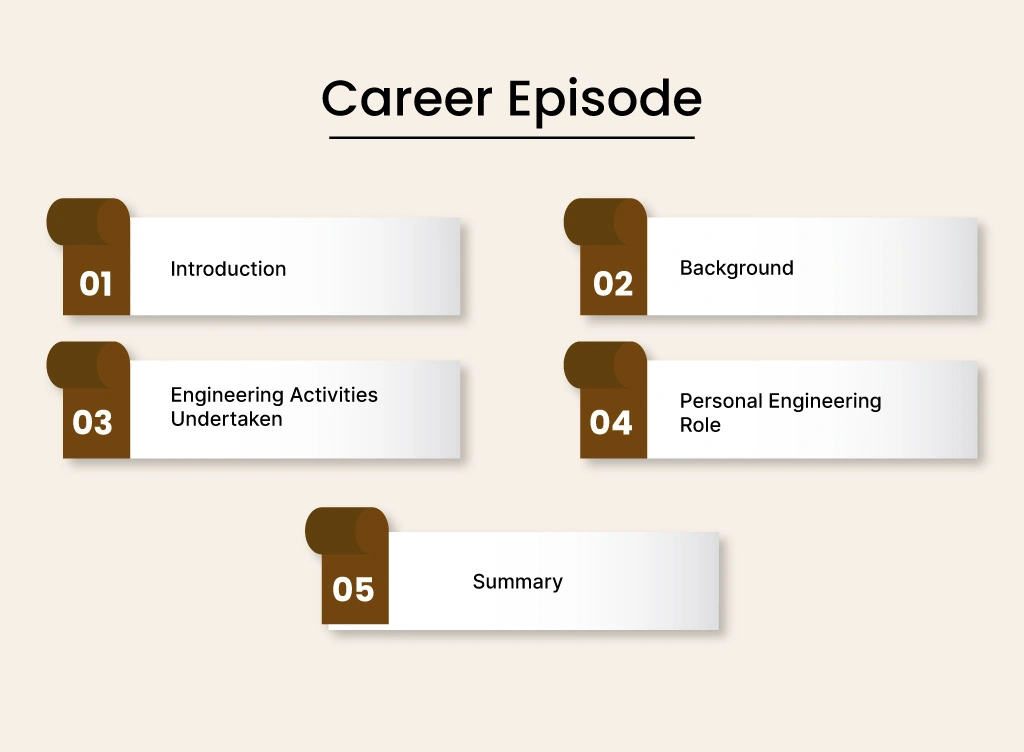Right CDR Report: Vital Step For Engineers Migrating To Australia

Right CDR Report: Vital Step For Engineers Migrating To Australia
A CDR (Competency Demonstration Report) is a document required by Engineers Australia for the assessment of the skills and qualifications of overseas engineers who wish to migrate to Australia and practice engineering there.
CDR Report: Vital Step for Engineers Migrating to Australia
A vital step for engineers migrating to Australia is preparing a Competency Demonstration Report (CDR). This essential document, required by Engineers Australia, showcases an engineer’s skills, qualifications, and professional experience.
It includes personal information, a record of Continuing Professional Development (CPD), detailed career episodes, and a summary statement. A well-prepared CDR is crucial for meeting Australian engineering standards and successfully navigating the migration process.
Let us discuss these points further:
I. Introduction to Competency Demonstration Report (CDR)
Purpose of CDR
The Competency Demonstration Report (CDR) is important for engineers migrating to Australia. It’s like a special report that shows off their engineering skills and qualifications to a group called Engineers Australia.
This group checks to ensure the engineers are good enough to work in Australia. So, the CDR is like a big spotlight that shines on all the cool things engineers can do!
Importance of CDR for Engineers Migrating To Australia
The CDR is super important for engineers who want to migrate to Australia. It’s like a special report that helps decide if they’re good enough to work there. Engineers Australia checks the report to see if the engineer’s qualifications and experience match what’s needed to work in Australia’s engineering industry. So, the CDR is like a key that unlocks the door to working in Australia as an engineer!
Overview of Engineers Australia (EA) and the CDR Assessment Process
Engineers Australia is like the boss who checks the special reports (CDRs) from engineers who want to migrate to Australia. They carefully look at the engineer’s qualifications, skills, and experiences to make sure they’re good enough to work in Australia as an engineer.
It’s like Engineers Australia sets the rules for what makes a good engineer in Australia, and they make sure everyone follows those rules. So, when engineers submit their reports, Engineers Australia checks them to see if they meet the standards needed to work in Australia.
II. Personal Information and Background
This part of the CDR is like the engineer’s personal profile. It includes a lot of details about yourself, like your full name, contact information, passport details, and where you studied. It also lists your work experience, including what jobs you had, what you did in those jobs, and how long you worked there. Lastly, it talks about what you, as an engineer, want to do in your engineering career. It’s like a snapshot of who you are and what you’ve done in your career.
III. Engineering Competencies
Introduction to Engineering Competencies
Engineering competencies are like the different parts that make up a good engineer. They include things like knowing a lot about engineering (technical proficiency), being able to solve problems, being good at talking to others about engineering stuff (communication skills), working well with others (teamwork), doing the right thing even when it’s hard (ethical conduct), and always trying to learn and get better at engineering (professional development).
So, it’s like having a bunch of different skills and qualities that make you a great engineer!
Identification of Relevant Competencies
In this part, the engineer talks about the skills they’re good at that are important for their specific type of engineering. They explain these skills in detail and show how they match what Engineers Australia wants to see.
These skills might be things like knowing a lot about their type of engineering (engineering knowledge), using engineering ideas to solve problems (application of engineering principles), leading a team on a project (project management), being a good leader, and being able to talk to others about engineering stuff (communication). It’s like they’re showing off their best skills and how they’re perfect for the job they want in Australia.
Demonstrating Competencies through Career Episodes
Career episodes are like stories that engineers tell to show how they’ve used their skills in real-life situations. Each story is about a specific project or experience the engineer has had.
They talk about what you did in the project, what your job was, and how you solved problems. They also explain what you have learned from the project and how it shows you’re good at the skills needed for engineering. It’s like telling a story about a big adventure where they used their engineering skills to save the day!
IV. Career Episodes for CDR Report

Career episodes are like chapters in a book that tell the story of an engineer’s experiences and achievements. It is very important for engineers migrating to Australia. Here, each chapter focuses on a particular time or project and has different parts, including:
Introduction
This is like the beginning of the chapter, where the engineer introduces the project or period they’re going to talk about.
Background
Here, the engineer gives some background information about the project or period. They might talk about why it was important or what problem they were trying to solve.
Engineering Activities Undertaken
This part is all about what the engineer did during the project or period. They talk about their tasks, responsibilities, and the work they did as engineers.
Personal Engineering Role
This section is about the engineer’s specific role in the project or period, like what you did, what decisions you made, and how you contributed to the project as an engineer.
Summary
This section is about the engineer’s specific role in the project or period. It talks about what they did, what decisions they made, and how they contributed to the project as engineers.
V. Summary Statement
The summary statement is like a report card that shows how well the engineer did on their projects. It’s a way to highlight all the good things they’ve done and how it proves they’re great at engineering.
It’s like shining a spotlight on their strengths and showing everyone how skilled they are in important areas of engineering.
Learn more: Writing a Compelling CDR Report for Australian Skilled Migration.✨💖
VI. Continuing Professional Development (CPD) Statement
The CPD statement is like a plan that shows how dedicated the engineer is to keep learning and growing in their career. It talks about all the extra things they’ve done to get better at engineering, like taking classes, going to workshops, or attending conferences.
VII. Curriculum Vitae (CV)
The CV is like a report card that shows the engineer’s journey so far. It lists where they went to school, all the jobs they’ve had, the things they’re good at, any awards they’ve received, and any clubs or groups they’re part of in the engineering world. It’s like a detailed map of their career that shows how skilled and experienced they are as engineers.
Conclusion
In conclusion, the summary brings together all the important things discussed in the CDR. It highlights the importance of a well-organized and honest competency demonstration report if an engineer wants to move to Australia successfully. It stresses the need to carefully follow Engineers Australia’s rules and standards while preparing the CDR.
In the end, the summary wraps up all the important stuff from the CDR. This clear explanation makes sure that every part of the CDR outline is fully understood, showing how the report should be put together and what needs to be included. Learn more about how to write CDR reports from CDR samples online for better preparation.
Frequently Asked Questions (FAQs)
1. What is the word count requirement for a CDR?
Engineers Australia usually wants CDRs to be around 1000 to 2500 words long. But it’s super important to check the latest guidelines from Engineers Australia to make sure the CDR is the right length.
2. How should career episodes be structured?
Career episodes need to have four main parts: introduction, background, engineering activities undertaken, and summary. Each part should give lots of details about the project or experience the engineer worked on. They should talk about what the engineer did, what their job was, and what they accomplished.
3. Can I include non-engineering work experience in my CDR?
Engineers Australia mainly looks at engineering qualifications and experiences, but you can include non-engineering work if it shows skills that can be used in engineering. However, most of your CDR should be about your engineering experiences and achievements.
4. Can I use the same career episodes for multiple engineering disciplines?
Engineers Australia wants each CDR to be about one specific kind of engineering. So, you should pick career episodes that match the type of engineering you’re applying for. Using the same episodes for different types of engineering might not show how good you are at each one.
5. How should I demonstrate my English language proficiency in the CDR?
To show you’re good at English, you need to include proof that you got the right scores on tests like IELTS, TOEFL, or PTE Academic. You should put this proof in the appendices of your CDR along with other documents.
6. Can I seek professional assistance in preparing my CDR?
While you have to make your own CDR, you can get help from CDR writing services or consultants like “CDR Genius,“ who know about Australian immigration. Just make sure the final CDR still shows your real experiences and skills.
7. What should I do if my CDR gets rejected by Engineers Australia?
If Engineers Australia says no to your CDR, they’ll tell you what you need to fix. You can fix those things and send your CDR again, or you can get more help from Engineers Australia or professionals to make your CDR better for them to check again.
8. How long does it take for Engineers Australia to assess my CDR?
The assessment timeframe for CDRs varies depending on the volume of applications and the complexity of the assessment. Engineers Australia typically provides an estimated processing time on their website. Applicants are advised to check the current processing times and plan accordingly.
 Chat with us
Chat with us